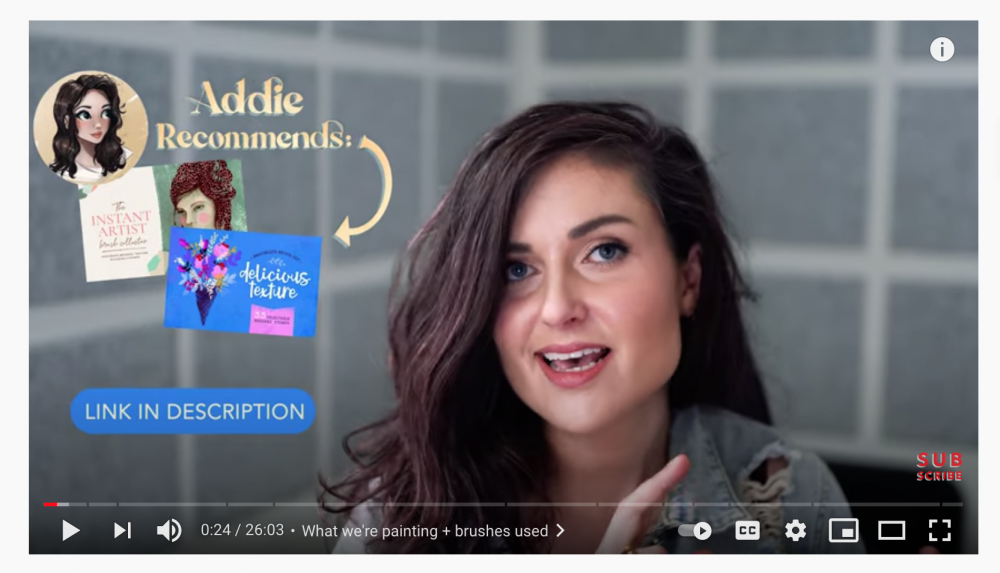There are a whopping 1.8 billion people using YouTube - and that’s growing daily - so it’s a very good place to connect with a relevant audience, share great product links and, if you do it right, get more than a few clicks and purchases as a result.
There are certain videos that lend themselves well to promoting DC affiliate links:
Product Reviews
There are a couple of ways that you can do reviews:
1) Simply pick a product and demonstrate all it’s features and talk about what you love about it and what it can be used for.
2) A comparison review, taking two different products that ultimately have similar characteristics. Showcase both products, but provide your favoured product choice, explaining why it wins. Both can be fab products, but you may simply prefer one because it’s more suitable for your style/needs. This gives you the opportunity to actually include 2 product links.
Both of these types of videos can be really effective, and they are not difficult to make. Simply share what you love about the products and don’t be afraid to include the drawbacks that you experienced too.
Providing an honest and thorough review will really help viewers go through the decision making process. The goal is to answer all questions in a video so those watching are ready to make a purchase with your affiliate link/s before they go.
Product Review - Video Examples
Here are a few great examples of good product reviews/comparisons from a few of our affiliates:
Tutorial Videos
Making tutorial videos, also known as a ‘how-to’ videos, for your YouTube channel is another great way to effectively get in front of an audience of people that you can make affiliate sales to.
There’s no hard and fast rules with tutorial videos, they can be long or short, at the end of the day it doesn’t matter as long as they provide the information needed for the project. Never just give partial information, because viewers will simply click away to another more in-depth tutorial. If you are limited for time, simply make the tutorial a smaller subject matter, i.e showing users how to create clipping masks, rather than a full tutorial on creating a character illustration for instance.
When you create your tutorial videos, show people step-by-step how you do things and what you use - hopefully at least one of the DC products, if not more. Since people see you using various products in the video, working in affiliate sales is easy - simply link in the video description and in video cards (we’ll talk through these things further on) to the things you used in the video.
Tutorial Video Examples
Best of Videos
These types of videos are a great way to bring a listicle to life and they’re pretty simple to do. Make a list of whatever you choose to promote - let’s say your Top 10 Procreate Brush Sets. In the video talk through the pros and cons of each product, feel free to demo what you’re explaining too.
To encourage viewers to stick around for the full list, start from number 10 and work your way up to the best of the best. You can link out to all of the products you mentioned in the video.
A great example of this is Will Paterson's Top 4 Fonts ...
How to Get Traffic to Your Videos
Related videos, titles and descriptions
Even if you create the most amazing videos, you won’t make a dent in your affiliate marketing if no one sees them. The great news is because YouTube is so vast as long as you are on the site and your videos are well-optimised you will get some traffic through ‘related videos’.
Related videos are exactly as they sound, when someone watches a video on YouTube you are shown similar videos that may be of interest to you following the first - encouraging viewers to click away to that video. Showing up in related videos is all about optimising your content by adding relevant keywords in your title, description and tags section. There are plenty of tools out there that can help you find the right keywords for your videos, but two of our favourites are VidIQ and TubeBuddy.
Video descriptions on YouTube can be up-to 5000 characters, so make sure you make the most of it, pack viewer friendly content in there (with a good smattering of your keywords) and don’t forget to include your affiliate link/s in the description too - adding your links above the fold is best practice (i.e. within the top of the screen before a user has to scroll)! A word of caution, don’t solely focus on keywords for the description, they are important, but you want it to be reader friendly too - there’s a fine balance!
ShoutBam do this really well. Check out a couple of examples from their channel below...
Once your video is being recommended as a YouTube related video two core factors really kick in for encouraging traffic to click. The first is the video title. If your title sucks everything else you’ve done won’t really matter, because if the title doesn’t engage viewers they’re not going to click to view.
The second core element is your video thumbnail. Thumbnails are the still images that you see on YouTube videos before you play them. Your thumbnail and title can significantly change your video's success so it’s worth giving it some real thought.
There’s been a fair few tests to find the sweet spot for thumbnails and on the whole capturing an image from the session itself and adding markups such as arrows, circles and authority logos are shown to work well and increase click through, but do test a few variations and see what difference your thumbnails can make.
Something that works well for our good friend Ian Barnard is this...
Play the algorithm game
The Youtube algorithm favours those who consistently put out content - publishing on a regular schedule really can make all the difference.
If time isn’t your friend, but you’d like to publish regularly a great tip is to choose a theme or topic to create video content on, but instead of making a single video you can break it down into smaller/shorter videos and focus each on a sub-theme. You’ll get a lot more content that you can publish on a frequent basis and the algorithm gods will give you more visibility.
Another great way to play the algorithm game with YouTube is through Playlists. YouTube reward channels who keep viewers watching. So rather than a video ending and a viewer exiting the channel, creating a playlist will mean once one video ends the next video that is relevant and likely to appeal to the viewer is automatically played; encouraging viewers to stay. If your viewers don’t exit immediately you get bonus points from YouTube’s algorithm and your visibility improves.
The core topic and sub-theme idea we mentioned above is a great way to create playlists, because if each video is part of a journey through a complete process there’s a higher likelihood a viewer will continue to watch.
Getting the most from search engines
Whilst your keywords used in your descriptions and titles are a big factor with search engine optimisation, another great way to improve ranking for your videos is by encouraging your viewers to like and comment on your content.
Take a few seconds in any video to ask those watching to take action and like, comment and share. Be sure to do this at least once in every video. The more likes, comments and shares your videos receive the better they are perceived by search engines.
Another great way to boost your videos visibility to search engines is via tags, which YouTube gives you the opportunity to add. Most people put 2 or 3 broad category tags and leave it at that, but if you are willing to put in a little more effort and mix in broader keywords with long tail versions you can really make a marked difference on your results. The two tools VidIQ and YouTube Buddy can help in your selection of tags.
Getting individuals to click on your affiliate links
Now you have traffic and viewers are clicking on your videos to watch, as well as ensuring you have your affiliate links within your description above the fold, there’s a couple of additional bits you can do to try and increase conversions:
- Use annotations - also known as text overlays - these can be text and/or web links, which sit over your video. Used in the right place at the right time during a video they are proven to increase engagement and click through rates. However, like with most things there’s a fine balance because they can also annoy viewers and make them exit your video if you go overboard, so use them sparingly, but do use them!
- Call to action - at the end of each video this is simply telling the viewer what to do next. This is typically the money making bit; i.e. “click the link below to buy this pack and create your own xxxx”. The key to an effective Call To Action is to make it short and to the point. And whilst it may sound like an obvious thing and you may question whether it is actually necessary to tell viewers to click on the link to buy, they really do make all the difference.
A great CTA example that really works is from Addie at Wooly Pronto as shown here...
As you do more and more YouTube videos, you can begin to tweak and play with other features and ideas, but the above is a pretty solid plan to get things going on the right footing.
And remember, when posting on YouTube, videos continue to rank and typically grow over time, earning month on month for years to come. Something you post once, can become a regular income stream without having to do any more to it for years - this is a real passive income stream.
No time like the present, lights, camera, action!

About The Author
A self-confessed Marketing geek, Jem Pennick is our Senior Marketing Manager at Design Cuts. Having worked in Marketing for nearly 20 years and with some of the world's biggest brands; including Fila, BRITA, Virgin Media and Hachette Book Group to name a few, Jem has a wealth of knowledge and experience.




Be the first to comment